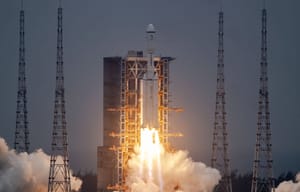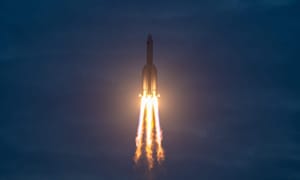
Mar 20, 2024
China launches new lunar communications satellite!
In the early hours of the 20th of March, a Long March 8 rocket lifted off from Launch Complex 2 at the Wenchang Space Launch Site. Onboard the rocket were three satellites bound for the Moon. The three satellites are Queqiao-2, Tiandu-1, and Tiandu-2.
The Long March 8 launch vehicle flew for the planned twenty-four minutes placing its second-stage and the three payloads onto a 200 by 420,000 kilometer orbit of Earth. Queqiao-2 separated from the second-stage first and successfully deployed its solar panels and antenna shortly after. Tiandu-1, carrying Tiandu-2, separated a reported two minutes later. All three of the spacecraft are reportedly health at this time as they head out towards the Moon.

Queqiao-2 is part of China's lunar exploration program and will assist in communications with the Chang'e 6, Chang'e 7, and Chang'e 8 robotic missions. The satellite currently has a planned lifespan of eight years.
In order to support these missions, Queqiao-2 will be in a 300 by 8600 kilometer orbit of the Moon at an inclination of fifty-five degrees. This will allow it to have a line of site with the southern part of the Moon for most of its orbit.

The satellite is building on top of experience gained with the Queqiao-1 satellite but is much larger weighing in at approximately 1,200 kilograms, Queqiao-1 is believed to have weighed 480 kilograms. Queqiao-2 will have a 4.2-meter parabolic antenna for its communication relay tasks.
The satellite will reportedly communicate in S and Ka bands for Earth communications, with lunar communications with Chang'e spacecraft being in X and UHF bands. The parabolic antenna that is used on the spacecraft is made of gold-plated molybdenum wires that are under 30μm in diameter.

Queqiao-2 is also carrying some science experiments onboard. These are an array neutral atom imager, an Earth-moon length baseline very long baseline interferometry experiment, and an extreme ultraviolet camera.
Also getting a ride to the Moon for this launch were the Tiandu-1 and Tiandu-2 spacecraft. The two spacecraft are experimental communications satellites that will help prove technologies for China's lunar communications relay and navigation constellation.

Tiandu-1 is believed to have a Ka band communications dish as well as a laser reflector, the small spacecraft weighs just sixty-one kilograms. Tiandu-2 is believed to be planned to stay attached to Tiandu-1 until it reaches the Moon before separating, it is reportedly carrying technological experiments and weighs just fifteen kilograms.

What is the Long March 8?
The Long March 8 is a two-stage launch vehicle manufactured by the China Academy of Launch Vehicle Technology and debuted in 2020. Prior to today's launch, the rocket had launched two times, both successfully. The launch vehicle burns rocket-grade kerosene and liquid oxygen in its first-stage and boosters with it burning liquid hydrogen and liquid oxygen in its second-stage.
According to official sources, the Long March 8 can lift up to 8,100 kilograms to low Earth orbit, 5,000 kilograms to a 700-kilometer sun-synchronous orbit, or 2,800 kilograms to a geosynchronous transfer orbit.

The boosters and the first-stage are powered by the YF-100 engine, with two being on the first-stage and one on each booster. These four engines generate a combined 490 tons of thrust at liftoff with the burn time of these stages being unknown outside of China excluding approximations made from launch footage.
The second-stage is powered by two YF-75 engines generating 17 tons of thrust burning liquid hydrogen and liquid oxygen. The burn time is also unknown outside of approximations but is capable of restarting once in space.
When fully fuelled ahead of launch the Long March 8 is believed to weigh 356,000 kilograms and stand 50.3 meters tall. The Long March 8 is also part of China's push away from the hyperbolic fuels that the older Long March rockets use over the coming years.
There are also rumors of partial reusability for the Long March 8 with the first-stage and boosters landing together downrange on a drone ship. The first-stage would be guided by grid fins to the drone ship before relighting its engines and deploying landing legs to land, akin to SpaceX's Falcon 9 landings.



